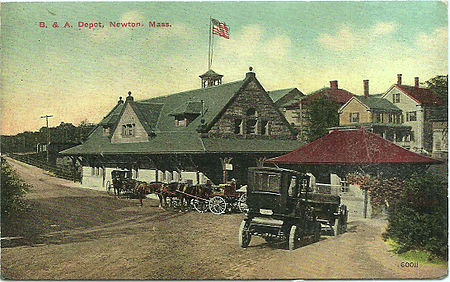Newton Corner station

Newton Corner was a streetcar and passenger rail station in the Newton Corner neighborhood of Newton, Massachusetts, located near where Washington Street crosses the Massachusetts Turnpike. The Newton Corner station, known simply as Newton for much of its lifetime, served commuters on the Worcester Line (run by the New York Central Railroad and its predecessors) from 1834 to 1959. The trolley stop, located on the surface streets, served a number of routes beginning in 1898, including the Green Line A branch until 1969. Newton Corner is now a stop and transfer point for a number of bus routes including high-frequency express routes to downtown Boston as well as local routes.
Excerpt from the Wikipedia article Newton Corner station (License: CC BY-SA 3.0, Authors, Images).Newton Corner station
Centre Street, Newton Newton Corner
Geographical coordinates (GPS) Address Nearby Places Show on map
Geographical coordinates (GPS)
| Latitude | Longitude |
|---|---|
| N 42.35756 ° | E -71.18441 ° |
Address
Centre Street
Centre Street
02172 Newton, Newton Corner
Massachusetts, United States
Open on Google Maps











